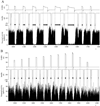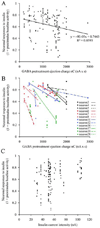In vivo electrophysiological effects of insulin in the rat brain
- PMID: 19541365
- PMCID: PMC2759775
- DOI: 10.1016/j.npep.2009.05.006
In vivo electrophysiological effects of insulin in the rat brain
Abstract
Brain insulin has widespread metabolic, neurotrophic, and neuromodulatory functions and is involved in the central regulation of food intake and body weight, learning and memory, neuronal development, neuronal apoptosis, and aging. To understand the neuromodulatory role of insulin, we aimed to characterize its yet undefined in vivo electrophysiological effects. We elected to record from the cerebellar cortex because this region has average insulin concentration and insulin receptor content in relation to the whole brain, and has been previously shown to be a target for insulin signaling. We used in vivo microiontophoresis to apply insulin juxtaneuronally while simultaneously recording changes in spontaneous neuronal activity. The analysis included 553 significant neuronal responses to insulin and other related agents recorded from 47 cerebellar neurons of the rat. We found that (1) insulin stimulation produced instant and reversible electrophysiological effects on all of the recorded neurons, and that (2) these effects were mostly dependent on prior or simultaneous GABA application (94-96%). Specifically, (a) inhibitory responses to insulin were the most common (58-62%), and were dose-dependent with respect to GABA pretreatments and blocked by co-administration of the insulin receptor inhibitor HNMPA. (b) In the second largest set of neurons (32-38%) insulin decreased the magnitude of GABA inhibitions when co-applied. (c) In contrast, only a small number of neurons showed GABA-independent responses to insulin application (4-6%), which were exclusively neuronal excitations. The present findings demonstrate that insulin has direct electrophysiological effects on central neurons in vivo and these effects are highly influenced by GABA-ergic inputs.
Figures







References
-
- Ali A, Ahmad FJ, Pillai KK, Vohora D. Evidence of the antiepileptic potential of amiloride with neuropharmacological benefits in rodent models of epilepsy and behavior. Epilepsy Behav. 2004;5:322–328. - PubMed
-
- Babri S, Badie HG, Khamenei S, Seyedlar MO. Intrahippocampal insulin improves memory in a passive-avoidance task in male wistar rats. Brain and cognition. 2007;64:86–91. - PubMed
-
- Banks WA. The source of cerebral insulin. European journal of pharmacology. 2004;490:5–12. - PubMed
-
- Banks WA, Kastin AJ, Huang W, Jaspan JB, Maness LM. Leptin enters the brain by a saturable system independent of insulin. Peptides. 1996;17:305–311. - PubMed
MeSH terms
Substances
Grants and funding
LinkOut - more resources
Full Text Sources
Medical

